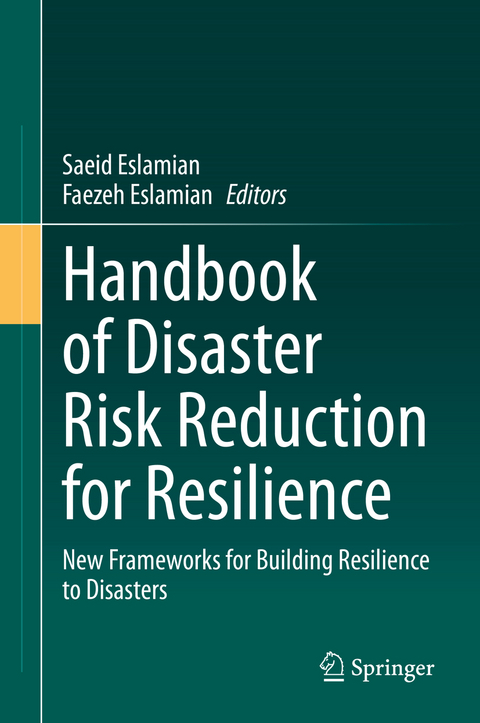
Handbook of Disaster Risk Reduction for Resilience
Springer International Publishing (Verlag)
978-3-030-61277-1 (ISBN)
This book is part of a six-volume series on Disaster Risk Reduction and Resilience. The series aims to fill in gaps in theory and practice in the Sendai Framework, and provides additional resources, methodologies and communication strategies to enhance the plan for action and targets proposed by the Sendai Framework. The series will appeal to a broad range of researchers, academics, students, policy makers and practitioners in engineering, environmental science and geography, geoscience, emergency management, finance, community adaptation, atmospheric science and information technology.
This volume discusses how to measure and build disaster resilience at society's capacity, drawing upon individual, institutional and collective resources to cope with and adapt to the demands and challenges of natural disaster occurrences. The book will serve as a guide, outlining the key indicators of disaster resilience in urban and rural settings, and the resources and strategies needed to build resilient communities in accordance with the targets of the Sendai Framework. Readers will learn about multi-risk reduction approaches using computational methods, data mining techniques, and System Thinking at various scales, as well as institutional and infrastructure resilience strategies based on several case studies.Dr. Saeid Eslamian is a Full Professor of Hydrology and Water Resources Sustainability at Isfahan University of Technology in the Department of Water Engineering. His research focuses mainly on statistical and environmental hydrology and climate change. In particular, he is working on modeling natural hazards including flood, drought, storm, wind, and pollution toward a sustainable environment. Formerly, he was a Visiting Professor at Princeton University, University of ETH Zurich, and McGill University. He has contributed to more than 400 publications in journals, books, or as technical reports, and he is the Founder and Chief Editor of both the International Journal of Hydrology Science & Technology and the Journal of Flood Engineering.
Chapter 1. Understanding Disaster Risk Reduction and Resilience: A Conceptual Framework.- Chapter 2. Types, Definition and Classification of Natural Disasters and Threat Level.- Chapter 3. Principles Regarding Urbanization, Disaster Risks and Resilience.- Chapter 4. Learning From Past Disasters to Prepare for the Future.- Chapter 5. New Frameworks for Building Resilience in Hazard Management.- Chapter 6. A New Framework for a Resilience-Based Disaster Risk Management.- Chapter 7. Urban Disaster Management and Resilience.- Chapter 8. Cascading Disasters: Multiple Risk Reduction and Resilience.- Chapter 9. Building Disaster Resilience through Primary and Higher Education.- Chapter 10. Mainstreaming Education into Disaster Management to Facilitate Disaster Resilience.- Chapter 11. Early Warning Systems to Strengthen the Resilience of Communities to Extreme Events.- Chapter 12. Developing Partnerships for Building Resilience.- Chapter 13. Disaster Resilience and Computational Methods for Urban Infrastructures.- Chapter 14. Dealing with Uncertainty using Fully Probabilistic Risk Assessment for Decision Making.- Chapter 15. A Conceptual Unified Model for Assessing Improvements in Sustainability and Resilience in Water Distribution Systems .- Chapter 16. Hazard Evacuation Management and Resilience: Case Study Examples in the U.S..- Chapter 17. Developing Factors for Socio-ecohydrological Resilience.- Chapter 18. Disaster Risk Reduction by Urban Resilience for Architectural Heritage.- Chapter 19. Insuring Natural Ecosystems as an Innovative Conservation Funding Mechanism: a Case Study on Coral Reefs.- Chapter 20. Spatio-Temporal Distribution of Landslides in Nepal
| Erscheinungsdatum | 06.04.2021 |
|---|---|
| Zusatzinfo | XVII, 487 p. 116 illus., 91 illus. in color. |
| Verlagsort | Cham |
| Sprache | englisch |
| Maße | 155 x 235 mm |
| Gewicht | 996 g |
| Themenwelt | Naturwissenschaften ► Biologie ► Ökologie / Naturschutz |
| Naturwissenschaften ► Geowissenschaften ► Geologie | |
| Technik ► Maschinenbau | |
| Schlagworte | Biodiversity conservation • Built Environment • Disaster resilience • Energy supply infrastructure • Hazard reduction • institutional resilience • natural resources and energy economics • Quality Control, Reliability, Safety and Risk • Sendai Framework • System Thinking |
| ISBN-10 | 3-030-61277-5 / 3030612775 |
| ISBN-13 | 978-3-030-61277-1 / 9783030612771 |
| Zustand | Neuware |
| Informationen gemäß Produktsicherheitsverordnung (GPSR) | |
| Haben Sie eine Frage zum Produkt? |
aus dem Bereich


